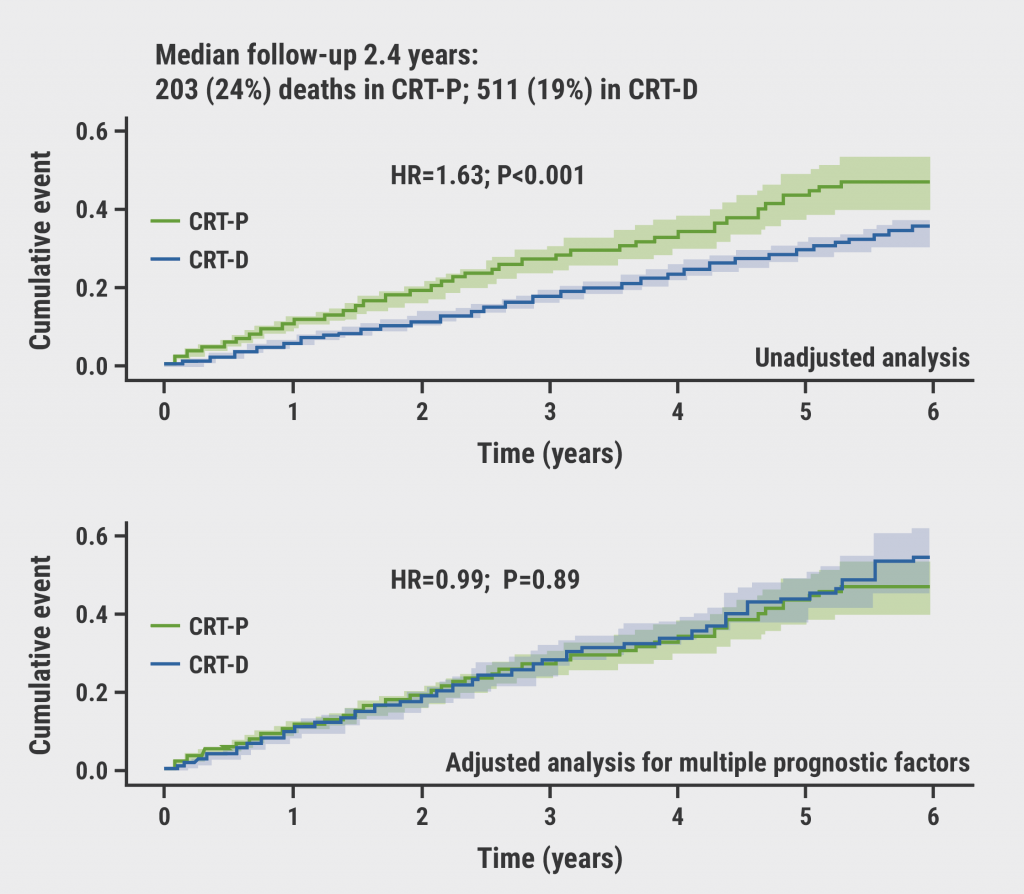https://doi.org/10.55788/4717cbf3
“Should patients with HF and an indication for CRT receive a defibrillator?” asked Prof. Nikolaos Dagres (Heart Center Leipzig, Germany) [1,2]. Since the risk of sudden cardiac death in this population has decreased in recent years due to improved medication, this issue has come into question [2]. The existing evidence on this topic is conflicting. A post-hoc analysis of the COMPANION trial (NCT00180258) suggested that CRT-D reduced all-cause mortality compared with CRT-P in patients with non-ischaemic cardiomyopathy (NICM) [3]. In contrast, a subgroup analysis of the DANISH trial (NCT00542945) did not display a benefit of CRT-D over CRT-P in patients with NICM [4]. A head-to-head trial comparing these devices was needed.
The RESET-CRT project includes a randomised clinical trial comparing CRT-D and CRT-P in patients with HF and an indication for CRT, and a retrospective observational part, mimicking the randomised trial. Prof. Dagres presented the results of the observational part, in which 847 patients with a CRT-P device and 2,722 patients with a CRT-D device were analysed [1,5]. All-cause mortality was the primary outcome of the study.
Baseline characteristics revealed a mean age difference of approximately 7 years between participants with CRT-P devices (76.7 years) and participants with CRT-D devices (69.9 years). Furthermore, patients with CRT-P devices were less often men (52% vs 65%) and were more likely to have atrial fibrillation (59% vs 41%), reflecting the situation in clinical practice.
After a median follow-up of 2.4 years, the non-adjusted analysis showed a reduced mortality rate in patients with CRT-D devices compared with those with CRT-P devices (24% vs 19%; HR 1.63; P<0.001) (see Figure). However, the age-adjusted analysis demonstrated no survival benefit of CRT-D over CRT-P (HR 1.13; P=0.165). Further adjustment for prognostic factors and comorbidities established that CRT-D did not outperform CRT-P in this population (HR 0.99; P=0.89).
Figure: Difference in all-cause death between CRT-P and CRT-D: unadjusted and adjusted results [1,2]

Reprinted from Hadwiger M, et al. Eur Heart J, Apr 3 2020. DOI: 10.1093/eurheartj/ehac053 under the terms of the Creative Commons CC BY-NC 4.0.
“After adjustment for age and comorbidities, we observed no survival difference between CRT-D and CRT-P, justifying the need for the randomised part of the RESET-CRT trial, which will provide a head-to-head comparison between the 2 devices,” concluded Dr Dagres.
- Dagres N, et al. Survival of cardiac resynchronization therapy patients with and without defibrillator: Real-world evidence from the observational part of the RESET-CRT project. Late-breaking science 1, EHRA 2022, 3–5 April, Copenhagen, Denmark.
- Barra S, et al. Eur Heart J. 2020;41:1976‒1986.
- Doran B, et al. JACC: Heart Failure. 2021;9(6):439‒449.
- Kober L, et al. N Engl J Med 2016;375:1221‒1230.
- Hadwiger M, et al. Eur Heart J. Apr 3, 2022. DOI: 10.1093/eurheartj/ehac053.
Copyright ©2022 Medicom Medical Publishers
Posted on
Previous Article
« Insertable cardiac monitors effective for AF detection in cryptogenic stroke Next Article
Focus on the efficacy of cardiac resynchronisation therapy in HF plus concomitant AF »
« Insertable cardiac monitors effective for AF detection in cryptogenic stroke Next Article
Focus on the efficacy of cardiac resynchronisation therapy in HF plus concomitant AF »
Table of Contents: EHRA 2022
Featured articles
Letter from the Editor
Diagnostics and Prevention
Cardiac magnetic resonance imaging improves prediction of post-MI sudden cardiac death
AI model accurately predicts sudden cardiac death in overall population
AI model accurately discriminates between arrhythmias
Impact of AF screening on stroke prevention influenced by systolic blood pressure
Developments in Devices
Conduction system pacing potential alternative for biventricular pacing in heart failure
Left bundle branch area pacing is a feasible technique for HF and bradyarrhythmia
Focus on the efficacy of cardiac resynchronisation therapy in HF plus concomitant AF
RESET: No survival benefit of CRT-defibrillator over CRT-pacemaker in heart failure
Insertable cardiac monitors effective for AF detection in cryptogenic stroke
Updates on Ablation
First results of the POWER FAST III trial
Real-world safety results on pulsed-field ablation with pentaspline catheter
VANISH: Ablation reduces shock burden compared with anti-arrhythmic drug in ventricular tachycardia
Low AF recurrence rates after PVI using pulsed-field ablation
Pulsed-field ablation reduces neurocardiac damage versus cryoballoon ablation
Ultrasound-guided femoral venipuncture reduces complications in catheter ablation
News on Atrial Fibrillation
Sex differences revealed in AF determinants and AF progression
Early rhythm-control therapy efficacious in men and women with AF
Progression in remote app-based monitoring of atrial fibrillation
Other Topics
Benefits of SGLT2 inhibitors may extend beyond HF-associated outcomes
© 2024 Medicom Medical Publishers. All rights reserved. Terms and Conditions | Privacy Policy


